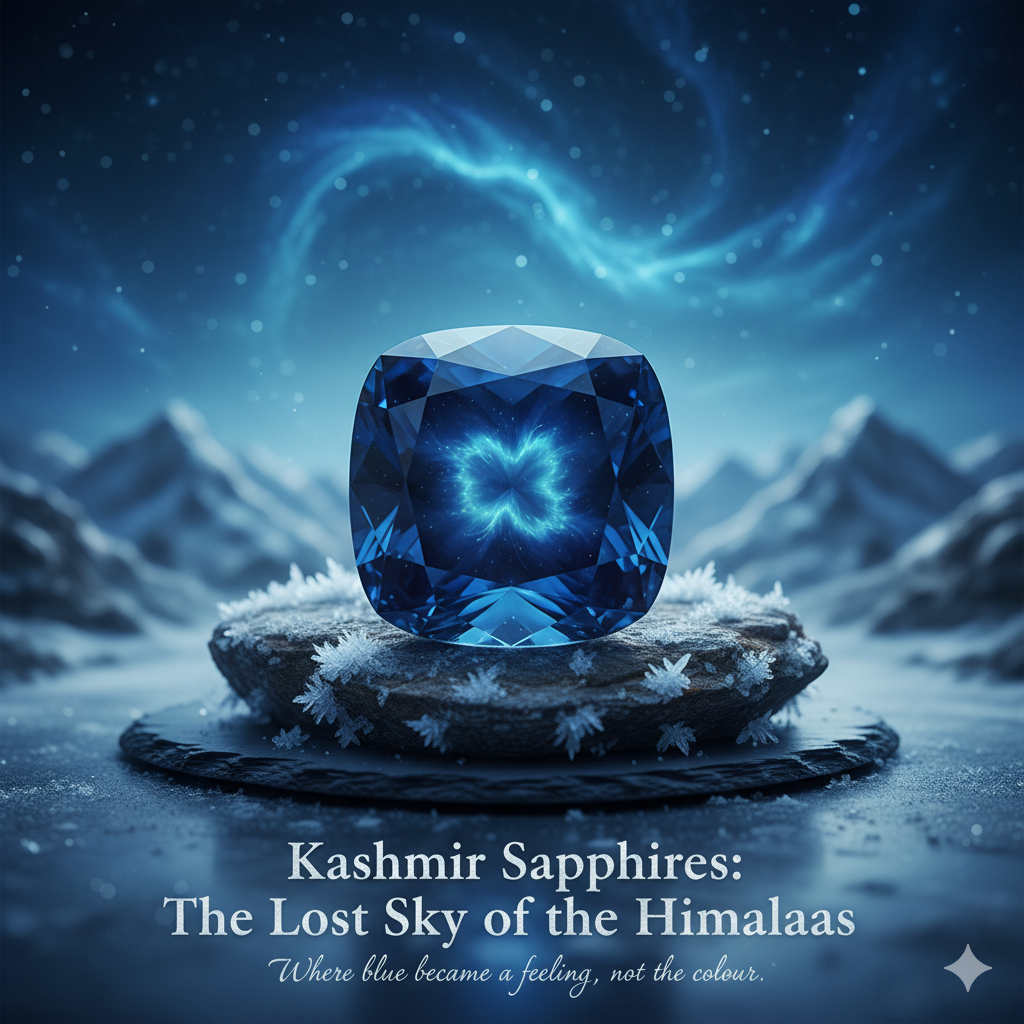Introduction
1. The Legend of a Valley in the Clouds
Some gemstones are beautiful.
A few are divine.
And one — just one — seems to have trapped the soul of the sky itself.
That is the Kashmir sapphire: a gem so hauntingly soft, so serenely blue, that even today, over a century after its mines went silent, the very word Kashmir carries a reverence unmatched by any other origin.
Discovered in the late 1870s to early 1880s, high in the Zanskar Range of the Indian Himalayas, the Kashmir sapphire was not merely a geological event — it was a moment of perfection in nature that would never fully repeat itself.
2. The Birth of the Blue
2.1 The Discovery
In 1881, a landslide in a remote part of Kashmir’s Padder Valley (now in the Kishtwar district, Jammu & Kashmir, India) exposed a deposit of velvety blue crystals embedded in soft pegmatitic rock.
Local shepherds and traders collected them and carried them to the Maharaja of Kashmir, who immediately recognized their value and placed the mine under royal control.
Thus began one of the most romantic — and short-lived — chapters in gem history.
2.2 The Mines: Sumjam and Gujran
The primary deposit, known as the Sumjam mine, lay at an altitude of over 4,500 metres (≈14,700 ft) — accessible only for a few months a year. A secondary deposit, Gujran, was discovered soon after but never matched Sumjam’s quality.
Mining was entirely manual, done by hand in freezing air, under royal guard. Even at its peak, the production was modest: perhaps 20–25 kg of rough per year, much of it small and fractured.
By 1887, the richest pockets (Tunnel Mine) were exhausted. Attempts to reopen the area in the early 1900s and again in the 1920s produced little. By 1930, the mines were effectively dead — sealed forever by altitude, exhaustion, and history.
3. The Science of the Sky
What makes a Kashmir sapphire instantly recognizable is its light.
Not just its colour — its texture of colour.
3.1 Colour and Tone
- Hue: Pure blue to violetish blue
- Tone: Medium to medium-dark
- Saturation: Intensely vivid yet velvety soft — due to submicroscopic inclusions scattering light.
The blue is neither cold nor electric. It is living skylight: luminous, misted, calm.
3.2 The “Velvet” Effect
Under magnification, Kashmir sapphires reveal wispy silk — fine rutile needles that create an even, diffuse glow.
This “silk veil” breaks up light just enough to give that uniquely soft-focus luminosity that no other sapphire source has replicated naturally.
It is the same optical principle as morning mist diffusing sunlight. The result: a gem that glows rather than sparkles.
3.3 Crystal Habit and Chemistry
- Mineral: Corundum (Al₂O₃)
- Inclusion Suite: Rutile needles, zircon crystals, boehmite.
- Trace Elements: Iron and titanium (Fe²⁺–Ti⁴⁺ intervalence charge transfer) with extremely low chromium and vanadium — leading to pure blue hue without secondary tints.
- Refractive Index: 1.760–1.770
- Specific Gravity: ~4.00
Microscopically, the inclusions are fine enough to retain brilliance while creating that misty diffusion — nature’s own filter.
4. Comparison with Other Origins
| Origin | Typical Colour | Clarity | Visual Character | Common Treatments | Distinctive Traits |
|---|---|---|---|---|---|
| Kashmir (India) | Pure, velvety blue | Slight silk, fine rutile | Soft radiance, “sleepy glow” | Rarely heated | The benchmark of beauty |
| Burma (Myanmar) | Deep royal blue | Very clean | Bold, vivid brilliance | Sometimes heated | High saturation, lustrous fire |
| Sri Lanka (Ceylon) | Lighter cornflower to violetish blue | Often very clean | Transparent sparkle | Commonly heated | Bright, lively tone |
| Madagascar (Ilakaka) | Similar to Ceylon | Clean | Slightly cooler hue | Often heated | Fine clarity, less velvet |
| Montana (USA) | Steely, greenish-blue | Clean | Metallic luster | Heated frequently | Distinctly modern hue |
Kashmir sits alone at the summit — its tone and texture unmatched, its rarity absolute.
5. The Era of the Maharajas
The Maharaja of Kashmir, alarmed by foreign interest, banned private mining early on.
The entire yield was collected under royal monopoly and sent to Jammu, Delhi, and Calcutta for cutting, often under supervision of British gem merchants.
In the 1880s–90s, the first Kashmir sapphires appeared in London, Paris, and Geneva, immediately commanding triple the price of any rival.
Collectors like Cartier, Van Cleef & Arpels, and Chaumet built entire parures around single Kashmir stones.
The royal inventories of India, Europe, and Persia soon featured them — radiant ovals that seemed to contain dusk and dawn at once.
6. Disappearance and Myth
By 1900, production was negligible.
By 1930, the mines were abandoned.
By 1950, “Kashmir” had become less a location and more a legend.
Today, no commercial mining exists there. The area is remote, high-altitude, and politically sensitive — under Indian administration near the Zanskar Himalayas, close to Ladakh.
Access is tightly restricted; the old mine entrances have long collapsed.
All Kashmir sapphires on the market are antique stones, re-cut or re-set from older pieces, occasionally appearing at auction through Sotheby’s, Christie’s, or Bonhams.
Each carries not just value, but provenance — lab reports from GRS, SSEF, Gübelin, or GIA confirming origin as Kashmir (India).
7. The Auction Record Trail
- Christie’s Geneva, 2015: 35.09 ct cushion Kashmir sapphire — USD 7.35 million
- Sotheby’s Hong Kong, 2020: 27.68 ct unheated Kashmir sapphire ring — USD 3.5 million
- Bonhams London, 2023: 16.9 ct cushion, AGL & SSEF certified — USD 1.8 million
- Average top-quality Kashmir sapphire: USD 1500–250,000 per carat, with rare museum stones crossing USD 300,000/ct.
The world’s finest examples reside in private royal collections and museum vaults — the Al Thani Collection, the Smithsonian, and several unnamed European families.
8. The Geology of Magic
Kashmir sapphires formed in aluminous pegmatitic veins within gneiss and schist — metamorphic hosts that underwent alpine-type metamorphism.
Age: approximately 25–30 million years (Tertiary Himalayan uplift).
Pressure-temperature conditions allowed slow crystallisation, which, combined with trace element purity, created the ideal optical balance.
Every gem from Sumjam carries the DNA of the Himalayas — slow uplift, perfect chemistry, and geological solitude.
They are, quite literally, pieces of sky trapped in rock.
9. The Counterfeits and Confusions
Because of their mythic value, Kashmir sapphires are the most misattributed gemstones in the world.
Common confusion arises with:
- Fine Burmese sapphires (which can appear velvety when lightly silky).
- Madagascar sapphires that mimic tone but lack the Kashmir “soft focus.” However some madagascar , sapphires especially from Bemainty in madagscar are notorious for Kashmir like silk . A closer examniation and age dating is often required to differentiate between the two .
- Sri Lankan stones falsely described as “Kashmir-like.”
High-end labs use advanced trace-element analysis (LA-ICP-MS) and inclusion fingerprinting to confirm Kashmir origin.
Typical indicators include:
- “Rutile dusting” (dense but even silk).AKA Streamers
- Absence of iron-rich growth zones.
- Distinct zoning under cross-polarised light (subtle snowflake pattern).
- Tourmaline Inclusions
- Kaolin
- Distinct Blocky Colour Zoning
- Pargasite inclusions
- Dust Tracks
- Tourmaline inclusions, Corroded Zircons
No modern deposit has duplicated the exact inclusion fingerprint of Kashmir sapphires — their microstructure is geologically unique.
10. The Myth vs. The Science
Why does Kashmir still hold power even though production stopped a century ago?
Because beauty in gemstones is not measured in abundance, but in unrepeatability.
Other sapphires can be more brilliant, cleaner, or darker.
But none reproduce that quiet, milky radiance — the sense that the gem is breathing its own light.
It is the difference between sunlight and skylight.
One dazzles; the other heals.
11. Ethical Legacy and Reverence
Unlike modern mines, Kashmir’s story predates industrial exploitation. There were no corporations, no explosives, no bulldozers — just hand tools and royal guards.
The extraction footprint was tiny, though poorly documented.
Today, the area is protected by Indian geological and forest authorities; unauthorized mining is strictly prohibited.
Occasional rumours of “new finds” in nearby Ladakh or Zanskar are typically either:
- secondary gravels eroding from the original pegmatite zone, or
- mislabelled Afghan or Pakistani sapphires sold as “Kashmir-type.”
Authentic new Kashmir stones have not entered the global trade for over 60 years.
12. The Emotional Grammar of Blue
Gemologists can measure refractive index, pleochroism, or trace element ratios — but they cannot measure calm.
Kashmir blue has a psychological quality no spectrometer can quantify.
It is not the brightness of youth; it is the serenity of wisdom.
Collectors often describe it as “blue with memory” — a colour that feels aged, gracious, and meditative.
Artists, too, have used Kashmir blue as metaphor:
- In poetry, for unattainable beauty.
- In painting, for divine detachment.
- In jewelry, for eternal restraint — the glow that never shouts.
13. The Modern Market
As of 2025:
- No new supply.
- All stones in circulation are historic or estate pieces.
- Every major gemological lab maintains separate reference databases for Kashmir origin.
High-end collectors (especially from Europe, Japan, the Gulf, and India) actively pursue certified Kashmir stones as “legacy assets” — heirlooms of geological and cultural perfection.
The demand remains fierce; the supply is frozen.
Kashmir sapphires now exist in the same symbolic category as:
- Golconda diamonds,
- Mogok pigeon-blood rubies,
- Colombian Muzo emeralds.
Each represents a once-only geological miracle.
14. PreciousCarats Reflection — The Light that Never Returned
If the world of gemstones were a cathedral, Kashmir would be its altar — quiet, unreachable, and bathed in soft blue light.
Its story teaches humility: that sometimes, beauty appears for only a moment in geological time — and then disappears, leaving behind only reverence.
At PreciousCarats, we treat the word Kashmir not as a sales term, but as a sacred geographical signature — a reminder that true rarity is not measured by carat weight, but by silence.
The mines are gone. The mountains sleep. But in every Kashmir sapphire, the sky still remembers how it once shone.

